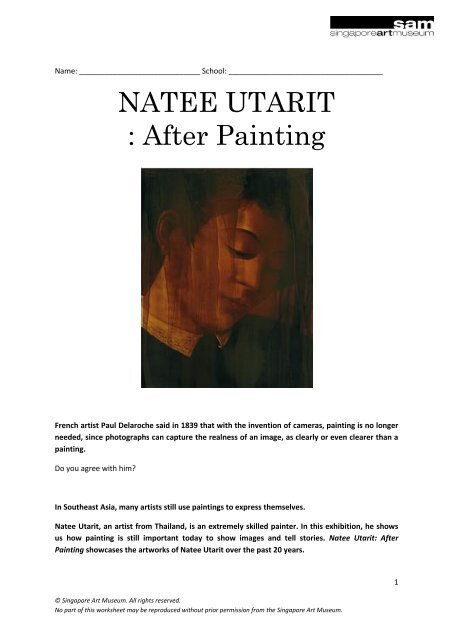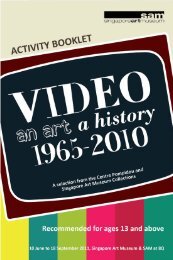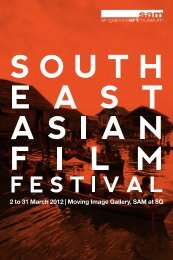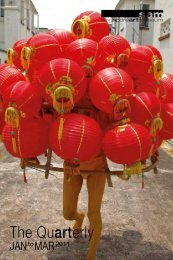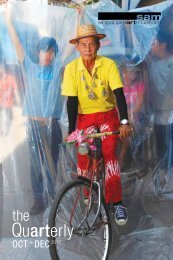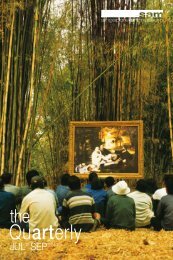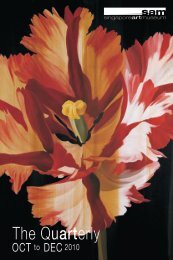NATEE UTARIT : After Painting - Singapore Art Museum
NATEE UTARIT : After Painting - Singapore Art Museum
NATEE UTARIT : After Painting - Singapore Art Museum
Create successful ePaper yourself
Turn your PDF publications into a flip-book with our unique Google optimized e-Paper software.
Name: _____________________________ School: _____________________________________<br />
<strong>NATEE</strong> <strong>UTARIT</strong><br />
: <strong>After</strong> <strong>Painting</strong><br />
French artist Paul Delaroche said in 1839 that with the invention of cameras, painting is no longer<br />
needed, since photographs can capture the realness of an image, as clearly or even clearer than a<br />
painting.<br />
Do you agree with him?<br />
In Southeast Asia, many artists still use paintings to express themselves.<br />
Natee Utarit, an artist from Thailand, is an extremely skilled painter. In this exhibition, he shows<br />
us how painting is still important today to show images and tell stories. Natee Utarit: <strong>After</strong><br />
<strong>Painting</strong> showcases the artworks of Natee Utarit over the past 20 years.<br />
© <strong>Singapore</strong> <strong>Art</strong> <strong>Museum</strong>. All rights reserved.<br />
No part of this worksheet may be reproduced without prior permission from the <strong>Singapore</strong> <strong>Art</strong> <strong>Museum</strong>.<br />
1
GO TO GALLERY 2.4: BEGINNING AFTER PAINTING<br />
In his earlier works, Natee Utarit wanted to think about how objects, subjects and landscapes can be shown<br />
in paintings.<br />
How many ways can you look at the same thing?<br />
1. Look for this painting, Exterior. How are these paintings different in colour?<br />
2. Now look for this painting, Interior, which is made up of four paintings placed side by side.<br />
Can you guess what is being painted here?<br />
© <strong>Singapore</strong> <strong>Art</strong> <strong>Museum</strong>. All rights reserved.<br />
No part of this worksheet may be reproduced without prior permission from the <strong>Singapore</strong> <strong>Art</strong> <strong>Museum</strong>.<br />
2
GO TO GALLERY 2.3: PAINTING AFTER PHOTOGRAPHY<br />
3. Look closely at this painting. What do you see?<br />
4. Does the image look like an animal, an object or a<br />
person?<br />
5. Compare this painting with Mother.<br />
The artist painted this picture when he thought about his mother. What words come to your mind<br />
when you look at this picture?<br />
Did you know?<br />
Natee Utarit is very close to his mother and his mother is being featured in both his paintings here. In Motr Figure,<br />
he es an abstract style to represent his mother while in Mother, he uses a more realistic style. Do you know what<br />
abstract and realistic style is? Search for their definitions on the internet!<br />
3<br />
© <strong>Singapore</strong> <strong>Art</strong> <strong>Museum</strong>. All rights reserved.<br />
No part of this worksheet may be reproduced without prior permission from the <strong>Singapore</strong> <strong>Art</strong> <strong>Museum</strong>.
Look for this painting, Kyotek Sae Wu 12 photographs during 1969 – 1973<br />
6. What do each of these paintings look like to you?<br />
7. Who are these people in the paintings? What do you think is their relationship to each other?<br />
Did you know?<br />
In the 1960s, a camera is a luxury item for most people, and the lucky ones who owned one often take photos at<br />
every opportunity to capture moments in their lives so that they can remember them in the future. Do you think<br />
paintings serve this purpose?<br />
4<br />
© <strong>Singapore</strong> <strong>Art</strong> <strong>Museum</strong>. All rights reserved.<br />
No part of this worksheet may be reproduced without prior permission from the <strong>Singapore</strong> <strong>Art</strong> <strong>Museum</strong>.
GO TO GALLERY 2.1 AND 2.2: PAINTING ABOUT PAINTINGS<br />
From 2000 to 2006, Natee Utarit started to look at paintings as images and as objects of art. He started to<br />
create paintings by painting one image on top of another so that we are looking at two different images<br />
within one painting.<br />
8. Look for this painting, Conversation with Bleaching Fields near Haarlem 1670-75, Jacob Van<br />
Ruisdael. Describe what you see.<br />
© <strong>Singapore</strong> <strong>Art</strong> <strong>Museum</strong>. All rights reserved.<br />
No part of this worksheet may be reproduced without prior permission from the <strong>Singapore</strong> <strong>Art</strong> <strong>Museum</strong>.<br />
5
Natee Utarit also re-created well-known masterpieces (famous paintings celebrated for their beauty and art<br />
technique) by famous western artists like Titian and Caravaggio, but he stained them brown so that people<br />
will think twice about what makes a masterpiece ‘beautiful’.<br />
9. Look for the paintings Judith and Couple. Can you see what is being painted clearly?<br />
10. Do you think these paintings are beautiful? Why?<br />
Did you know?<br />
The masterpieces that both paintings are based on are known as Judith Beheading Holofernes by Caravaggio and<br />
The Three Ages of Man by Titian. Try search for images of these masterpieces on the internet and see how different<br />
Natee Utarit has treated them<br />
6<br />
© <strong>Singapore</strong> <strong>Art</strong> <strong>Museum</strong>. All rights reserved.<br />
No part of this worksheet may be reproduced without prior permission from the <strong>Singapore</strong> <strong>Art</strong> <strong>Museum</strong>.
Look for this painting, Beautiful Portrait of Beautiful Photograph of Beautiful Classical Sculpture.<br />
11. This is a painting of a sculpture. Have you seen sculptures before? Where did you see them?<br />
Where else do you think you can find sculptures?<br />
12. If you make a sculpture of someone, who would that person be, and why? Draw your<br />
sculpture in the space below.<br />
© <strong>Singapore</strong> <strong>Art</strong> <strong>Museum</strong>. All rights reserved.<br />
No part of this worksheet may be reproduced without prior permission from the <strong>Singapore</strong> <strong>Art</strong> <strong>Museum</strong>.<br />
7
13. Look for this painting, Asian Renaissance. What colours do you see in this painting?<br />
14. If you could give this painting another name, what would it be? Why?<br />
8<br />
© <strong>Singapore</strong> <strong>Art</strong> <strong>Museum</strong>. All rights reserved.<br />
No part of this worksheet may be reproduced without prior permission from the <strong>Singapore</strong> <strong>Art</strong> <strong>Museum</strong>.
GO TO GALLERY 1.1 AND 1.2: PAINTING AS NARRATIVE<br />
From 2005 to 2009, Natee Utarit started to use the characters in his paintings to tell a story. In this gallery,<br />
his paintings are stories about Thailand and the Thai society.<br />
<strong>Painting</strong>s are not just images – they can tell stories too.<br />
15. Symbols are images, characters, or figures used to represent something else that share the<br />
same value or meaning to it. For example, a heart shape represents love, while smiley<br />
face is used to express happiness.<br />
What about an upside down horse as seen in this painting White Horse? What do you think<br />
it means to have the horse painted upside down?<br />
16. A horse usually has a knight riding it, but the knight seems to be missing here. What do you<br />
think happened to the knight?<br />
© <strong>Singapore</strong> <strong>Art</strong> <strong>Museum</strong>. All rights reserved.<br />
No part of this worksheet may be reproduced without prior permission from the <strong>Singapore</strong> <strong>Art</strong> <strong>Museum</strong>.<br />
9
17. Look for the paintings Micro History of Politic No. 3 – Lost and Tragedy.<br />
Look closely at the animals on the left and on the right. What do you think happened? Write<br />
a short story on why the animals have fallen down.<br />
© <strong>Singapore</strong> <strong>Art</strong> <strong>Museum</strong>. All rights reserved.<br />
No part of this worksheet may be reproduced without prior permission from the <strong>Singapore</strong> <strong>Art</strong> <strong>Museum</strong>.<br />
10
18. What do the green soldiers here in this<br />
painting, Green Soldier, look like to you?<br />
19. What do you think these soldiers are doing?<br />
How would you feel if you were one of these<br />
soldiers?<br />
20. Look for The Prince.<br />
Look closely at the Prince in this painting. What is<br />
wrong with his body?<br />
11<br />
© <strong>Singapore</strong> <strong>Art</strong> <strong>Museum</strong>. All rights reserved.<br />
No part of this worksheet may be reproduced without prior permission from the <strong>Singapore</strong> <strong>Art</strong> <strong>Museum</strong>.
21. Look for The western light no. 1 and Long Live The King. What are the colours used in these<br />
two paintings?<br />
22. How do these colours make you feel? If you could change the colours of this painting, what<br />
colours would you use and why?<br />
23. The King in the paintings is looking away. What do you think he is looking at, and what might he<br />
be thinking about?<br />
-END-<br />
© <strong>Singapore</strong> <strong>Art</strong> <strong>Museum</strong>. All rights reserved.<br />
No part of this worksheet may be reproduced without prior permission from the <strong>Singapore</strong> <strong>Art</strong> <strong>Museum</strong>.<br />
12
Suggested answers for Natee Utarit worksheet<br />
1. The one on the left is more bright and fresh with colours like yellow and green, whereas the<br />
one on the right is duller, with colours like grey and dark green. It looks like the landscape on<br />
the left is painted during summer time while the one on the right is done during winter time.<br />
2. An interior of a room is being painted here, with the focus on different corners of the floor<br />
and the wall.<br />
3. From the title, we know this painting shows a mother figure. We can make out a female<br />
figure seated on the ground with her head bowed down and her legs curled beneath her<br />
(the brown section represents her hair while the white section represents her body).<br />
4. Students’ free response to whether the image looks like an animal/person/object.<br />
5. Students’ free response. Example of words: loving, caring, kind, warm, nurturing. etc<br />
6. The individual panels look like photographs.<br />
7. It’s a young boy and a middle-aged couple. They look like a family (mother, father and son).<br />
8. Students’ own response. Suggested answer: It looks like a photograph is being pasted in the<br />
middle of a landscape painting. Student can also describe the picture- I see clouds, grassy<br />
fields, etc.<br />
9. No, we cannot make out what is being painted here clearly, because the original subjects<br />
have been stained over by a brown stain, so the colours and outline are not seen clearly.<br />
If the student thinks it is pretty easy to make out the images on the paintings- it looks like<br />
both paintings are of women/females.<br />
10. Students’ personal response. Suggested answer: Yes, because we can still make out the<br />
meticulously painted subjects that were done in great detail.<br />
OR: No, because the paintings look dirty/old/the colours are dull.<br />
11. Students’ free response to whether they have seen a sculpture before, and if they have,<br />
where.<br />
You can find such classical sculptures in art studios, art schools/classrooms, museums, or<br />
public places where busts of important people are put up to commemorate their<br />
achievements or contributions.<br />
12. Students’ free response to who they would want to make a sculpture of, and consequently<br />
drawing the picture in the space.<br />
13. Students’ free response. Suggested answer: yellow, brown, green, grey, white, black, red,<br />
orange.<br />
14. Students’ free response.<br />
1
15. Students’ personal response to what an upside down horse means to them. (e.g. a horse in<br />
trouble/a confused horse, etc)<br />
16. Students’ free response to what they thought happened to the knight. (e.g. he got<br />
kidnapped/lost/hunting, etc)<br />
17. Student’s free response to what happened to the animals. Suggested answers- they fell<br />
ill/there was a hurricane/they all could not get along and died)<br />
Students are free to express their creativity when writing the story as long as it fits the<br />
paintings.<br />
18. Suggested answer: the green soldiers look like plastic toys.<br />
19. The soldiers look like they are in battle/war/about to fight an enemy.<br />
Free response to how the student would feel if he/she were one to the green soldiers.<br />
Feelings can be- fearful/ scared/terrified/worried/ charged-up to fight/prepared.<br />
20. The Prince’s head and body/torso is facing in opposite directions.<br />
21. Colours: black, grey.<br />
22. Students’ personal response to how the above colours make them feel. E.g.<br />
sad/solemn/gloomy/moody/mysterious/tranquil/cold.<br />
23. Student’s free response to what they think the King might be looking at and thinking about.<br />
(e.g. I think the King is looking over his kingdom and is thinking about how good his country<br />
is.)<br />
2


